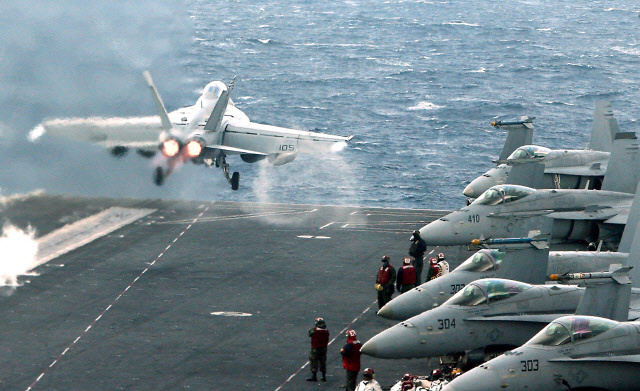Posted on : Dec.11,2018 17:35 KST
 |
|
A US fighter jet takes off from an aircraft carrier during a military exercise
|
US President Donald Trump wants South Korea’s share of the joint defense burden to go up by 50% or even 100% from its current level as of next year, the Wall Street Journal reported. This year, South Korea contributed 960.2 billion won (US$850.1 million) to cover the cost of stationing US troops in the country. If this report can be taken at face value, Trump is effectively asking for South Korea’s contribution to be raised to between 1.44 and 1.92 trillion won (US$1.27-1.7 billion). That’s an absurdly excessive demand.
During the 9th defense cost-sharing negotiations in Jan. 2014, South Korea and the US agreed to raise the former’s share of the defense costs by 5.8% from the previous year. But there’s no reason to raise the cost of maintaining US troop presence by 50 or 100% in just five years. If anything, the demand for additional military construction is likely to fall, if the relocation of the Yongsan Garrison to Pyeongtaek is completed in 2020 as planned.
And with the sharp decline in military provocations by North Korea this year, the chances of US Forces Korea (USFK) undertaking military operations in response to a crisis situation are decreasing as well. The reality is that there are more reasons that the cost of keeping US troops here will fall, rather than rise. The South Korean government needs to plead its case to the US so that the two sides can reach a reasonable compromise.
The fact is that South Korea is already shouldering a substantial share of its defense burden. While the US argues that South Korea’s share amounts to a little over 50% of the cost of stationing troops here, an analysis by South Korean NGOs suggests that its actual share is over 65%, since South Korea also provides land, facilities, tax benefits and waivers from various fees in addition to its financial contribution. This amount is by no means small when compared with the support Japan gives to US troops stationed there.
According to figures released in May by the Korea Institute for Defense Analyses (KIDA), South Korea’s defense share is less than Japan’s on a strictly numerical level, but it’s between 50% and 160% higher when calculated relative to the number of US soldiers stationed in the country or relative to gross domestic product (GDP). The US negotiators who are in the 10th round of defense cost-sharing talks, which have been underway since the beginning of the year, have reportedly been rather inflexible, perhaps because their president has personally instructed them to greatly increase South Korea’s share.
But deterrence against North Korea is not the only purpose of American troops on the Korean Peninsula. Following South Korea and the US’ agreement during the presidency of Roh Moo-hyun to grant USFK “strategic flexibility,” they aren’t even a garrison anymore. USFK also serves US strategic interests by maintaining stability in Northeast Asia and countering China.
Exploiting South Korea’s dependence upon US troops for a large part of its deterrence against North Korea as leverage to demand an excessive amount of money isn’t beneficial for the South Korea-US alliance either.
Please direct comments or questions to [english@hani.co.kr]






